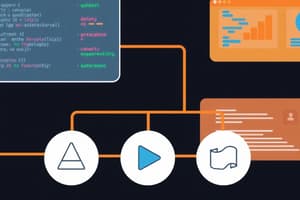Podcast
Questions and Answers
Which programming paradigm emphasizes responsiveness and efficiency by executing programs based on specific events?
Which programming paradigm emphasizes responsiveness and efficiency by executing programs based on specific events?
- Object-oriented programming
- Event-driven programming (correct)
- Procedural programming
- Functional programming
What is one primary benefit of event-driven programming in terms of handling tasks?
What is one primary benefit of event-driven programming in terms of handling tasks?
- Exclusively polling for changes
- Concurrently managing inputs and outputs (correct)
- Handling tasks sequentially
- Ignoring event-handling logic
How does event-driven programming support asynchronous execution?
How does event-driven programming support asynchronous execution?
- By waiting for a single event handler to complete
- By blocking the program when events occur
- By triggering actions based on events without blocking the program (correct)
- By exclusively executing event handlers sequentially
In GUI programming, what components generate and handle events based on user interaction?
In GUI programming, what components generate and handle events based on user interaction?
What makes event-driven programming ideal for GUI applications?
What makes event-driven programming ideal for GUI applications?
What is a key advantage of event-driven programming for handling multiple inputs and outputs?
What is a key advantage of event-driven programming for handling multiple inputs and outputs?
What role do event listeners play in event-driven programming?
What role do event listeners play in event-driven programming?
Which term best describes the mechanism behind event listeners in GUI applications?
Which term best describes the mechanism behind event listeners in GUI applications?
What is a major challenge associated with event-driven programming?
What is a major challenge associated with event-driven programming?
How do event listeners contribute to responsive GUI applications?
How do event listeners contribute to responsive GUI applications?
What is a key advantage of using an event-driven approach in programming?
What is a key advantage of using an event-driven approach in programming?
In event-driven programming, what is crucial for successful execution of event-handling logic?
In event-driven programming, what is crucial for successful execution of event-handling logic?
Flashcards are hidden until you start studying
Study Notes
Introduction
Event-driven programming is a paradigm that emphasizes responsiveness and efficiency by allowing programs to execute based on the occurrence of specific events. This approach is particularly useful in creating interactive and dynamic applications, such as those found in graphical user interfaces (GUIs) and real-time systems.
Benefits of Event-Driven Programming
One of the primary benefits of event-driven programming is its ability to handle multiple inputs and outputs simultaneously. Instead of continuously polling for changes, event-driven programs can efficiently manage concurrent tasks by isolating event-handling logic. This leads to improved resource utilization and enhanced modularity, making it easier to scale and maintain applications in a rapidly changing technological landscape.
Another advantage of event-driven programming is its support for asynchronous execution. In this model, actions are triggered by events, allowing the program to continue executing without being blocked by individual event handlers. This non-blocking nature makes it ideal for GUIs and server-side technologies where multitasking is essential.
GUI Programming with Event-Driven Programming
GUI applications rely heavily on event-driven programming to create responsive and user-friendly interfaces. Widgets, buttons, menus, dialogs, and other components generate and handle events based on user interaction, enabling instant feedback and updates.
For example, suppose you develop a desktop or mobile app that includes a form with text fields and a submit button. As the user fills out the form, the program will listen for events related to input changes and button clicks. Once the user submits the form, the associated event handler would trigger the appropriate action, such as sending the data to a server for further processing.
This event-driven approach allows GUI applications to remain responsive while minimizing resource consumption, leading to smoother user experiences across various platforms.
Event Listeners
Event listeners play a crucial role in event-driven programming by tracking and responding to specific events. They serve as the connection between the source of the event, such as a user clicking a button, and the desired action, like displaying a popup window or updating a label.
To illustrate how event listeners function, consider a web application built using JavaScript, HTML, and CSS. Users can interact with the site by clicking links, filling out forms, or scrolling through content. As they engage with the page, their actions generate events that are then captured by event listeners. These listeners determine which handlers should be executed based on the type of event and relevant data received.
Event listeners can also help facilitate asynchronous communication between different components within an application. For instance, when a form is submitted, multiple listeners might capture the action and trigger corresponding tasks such as validation, error handling, and data processing.
Challenges of Event-Driven Programming
While event-driven programming offers many benefits, there are also challenges associated with its implementation. One challenge lies in managing concurrent tasks efficiently to avoid conflicts or errors that may arise from overlapping events or dependencies. Careful coordination and clear design of the event model are essential for ensuring successful execution of event-handling logic.
Another challenge is debugging and testing event-driven applications due to the potential complexity introduced by numerous sources of events, unpredictable order of execution, and asynchronous behavior. Developers must ensure that each event handler responds appropriately to various scenarios without causing unexpected side effects or interacting improperly with other modules.
In conclusion, event-driven programming provides a powerful framework for creating interactive, responsive, and efficient applications across diverse fields such as computing, robotics, and automation. By leveraging the principles of this paradigm, developers can create dynamic systems capable of handling multiple inputs and outputs while maintaining optimal resource utilization and modularity. However, careful planning and understanding of event handling mechanisms are necessary to overcome the associated challenges and achieve successful implementation.
Studying That Suits You
Use AI to generate personalized quizzes and flashcards to suit your learning preferences.




